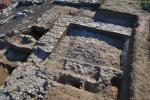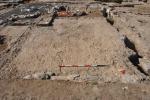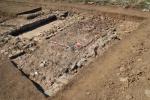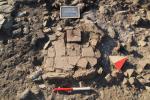Summary (English)
This season excavations continued in the south-eastern part of the city, immediately east of the Cardo Maximus
So far a surface area of over 1000 m2 has been excavated, corresponding with a part of an insula occupied by two domus, defined south domus and north domus, both built in the late Republican period. (Fig. 1)The excavations concentrated on the area occupied by room 4 (atrium) where a new area of the opus scutulatum was exposed (Fig. 2).
Thanks to some robbing of this floor surface it was possible to identify the underlying floor make-up for another mosaic surface and the structures of an earlier impluvium, datable to between the late 2nd century and the 1st century B.C., as suggested by the mass of materials dating to this period found during the excavation.Another sector of the large quadrangular building (identified in 2017), formed by at least two rooms came to light in room 4 (Fig. 3). Excavation mainly took place in the east room, where the floor make-up was identified. This was made up of clay, lumps of mortar and numerous fragments of decorated plaster, attributable to the Second Pompeian Style, which probably came from the destruction layers of the domus (Fig. 4). The few ceramics found in the layer (in particular terra sigillata) suggest the floor dates to no earlier than the first or second half of the 1st century A.D.
Rooms 5 and 6 were then investigated. The fill in a large circular hole situated in the north-eastern corner of room 5 was excavated. The hole cut the layer of rubble present in the room and the underlying floor surfaces and make-ups. It also cut an earlier trench dug to rob the north wall of the south domus, datable to around the second half of the 7th century A.D. Lastly, the layer of mortar and plaster fragments occupying the entire surface of room 5 was removed. The layer had been put down in the imperial period to form a floor surface. This layer overlay a floor made of mortar and crushed marble (Fig. 5).
In the northern sector, the investigations concentrated on the 6th-7th century phases, which followed the abandonment of the production area, probably a fullonica that occupied the north domus in the 4th-5th centuries. A large rectangular room, 3.2 × 7 m (Fig. 6) was identified here. Floor surfaces and make-ups were uncovered that date to the final decades of the 6th and the 7th centuries. At the centre of the room, which reused the walls of the domus and newly constructed walls, there was a hearth built in broken tiles placed flat and bordered by schist stones placed on edge (Fig.7).
Other structures were present to the east – a series of postholes belonging to a single structure – and various dumps of building materials and pottery, which belonged to the same chronological horizon as the rectangular room, thus providing a wealth of information about the occupation phases at Luni during the Byzantine and Lombard periods.
- Simonetta Menchelli - Università degli Studi di Pisa Dipartimento di Civiltà e Forme del Sapere
- Paolo Sangriso - Università degli Studi di Pisa, Dipartimento di Civiltà e Forme del Sapere
- Stefano Genovesi – Università degli Studi di Pisa, Dipartimento di Civiltà e Forme del Sapere
- Alberto Cafaro - Università degli Studi di Pisa, Dipartimento di Civiltà e Forme del Sapere
- Rocco Marcheschi - Università di Pisa Dipartimento di Civiltà e Forme del Sapere
Director
- Simonetta Menchelli - Università degli Studi di Pisa Dipartimento di Civiltà e Forme del Sapere
Team
- Rocco Marcheschi - Università di Pisa Dipartimento di Civiltà e Forme del Sapere
- Paolo Sangriso - Università degli Studi di Pisa, Dipartimento di Civiltà e Forme del Sapere
- Silvia Marini - Università degli Studi di Pisa, Dipartimento di Civiltà e Forme del Sapere
- Stefano Genovesi – Università degli Studi di Pisa, Dipartimento di Civiltà e Forme del Sapere
- Alberto Cafaro - Università degli Studi di Pisa, Dipartimento di Civiltà e Forme del Sapere
Research Body
- Università di Pisa Dipartimento di Civiltà e Forme del Sapere
Funding Body
- Amici di Luni, Luni
- Comune di Luni
- Università di Pisa Dipartimento di Civiltà e Forme del Sapere






![Download [PDF]](/excavation/skins/fasti/images/results/download_sml.png)





